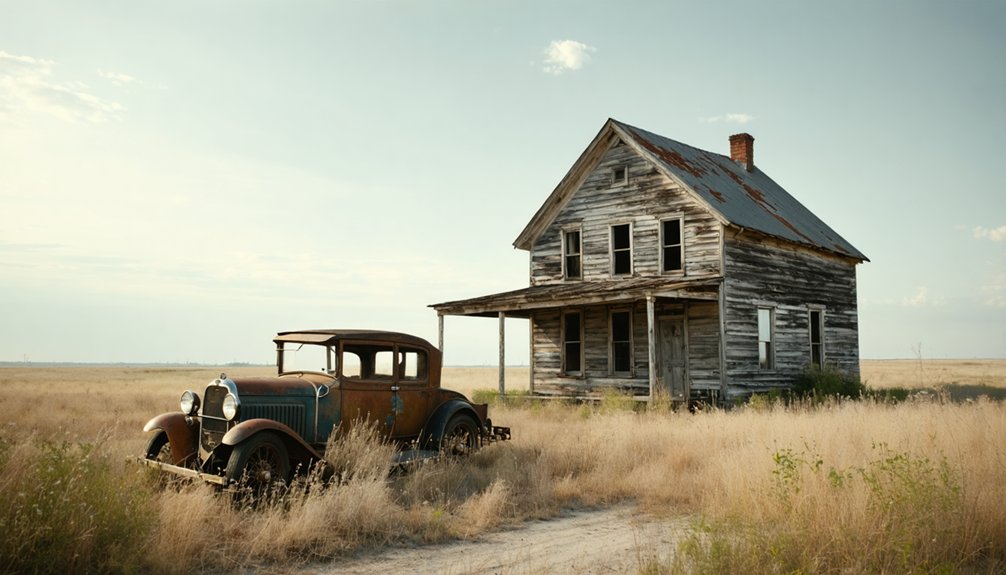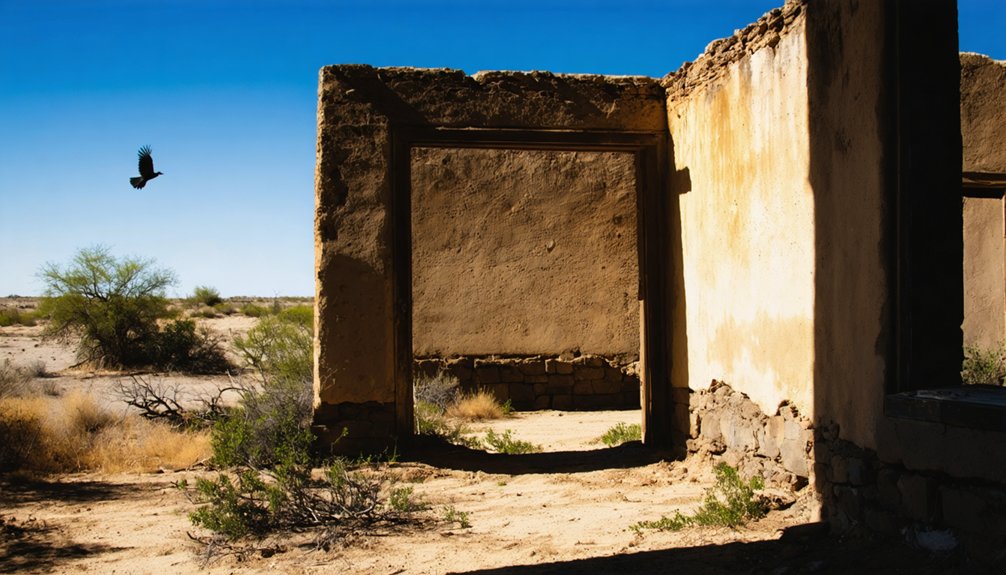You’ll find Cañada Verde at the intersection of FM roads 1303 and 3444 in western Wilson County, Texas. This Civil War-era settlement thrived as a farming community, establishing a school in 1896 that enrolled 71 students. By 2000, the population dwindled to just 23 residents, and today only stone foundations and crumbling adobe walls mark where this frontier town once stood. The town’s rich history of military connections and European influences holds countless untold stories.
Key Takeaways
- Cañada Verde is a ghost town in Wilson County, Texas, located at the intersection of FM roads 1303 and 3444.
- Founded during the Civil War era, the town peaked in the early 1900s but declined due to lack of railroad access.
- By 2000, the population had dwindled to just 23 residents, with most original structures deteriorated or destroyed.
- Only stone foundations and chimneys remain from the 19th-century buildings that once formed this farming community.
- The closure of the local school after World War II marked the beginning of the town’s transformation into a ghost town.
Origins and Early Settlement
While many Texas frontier settlements emerged from military posts, Cañada Verde developed as a small community around the time of the Civil War at the intersection of what would later become Farm to Market roads 1303 and 3444.
You’ll find its early settlement patterns were shaped by both geographic advantage and military influence from nearby outposts, which helped protect settlers from Native American conflicts in the region.
Like other frontier towns, Cañada Verde’s strategic location at a crossroads made it an important node for local trade and transportation.
Located at a crucial crossroads, Cañada Verde emerged as a vital frontier hub connecting trade routes across nineteenth-century Texas.
Similar to how safe river crossings determined settlement locations, the town’s placement was crucial for early development.
The area gained attention when the U.S. Army established a camel research station in 1855 to study the animals’ military potential.
As settlers established homes and businesses, they balanced agricultural pursuits with commerce, serving the needs of travelers and nearby communities.
The town’s growth reflected the broader expansion trends of 19th-century Texas, where pioneers sought both economic opportunity and security.
Geographic Location and Layout
Situated at the crossroads of Farm to Market Roads 1303 and 3444 in western Wilson County, Cañada Verde occupies a strategic position on the South Texas Plains at coordinates 29°11′32″N, 98°16′34″W.
You’ll find this ghost town about 8 miles northwest of Floresville at an elevation of 410 feet above sea level. The site’s geographic features include gently rolling terrain with grasslands and scattered trees, reflecting the region’s agricultural significance. The town’s location places it approximately 19 miles south of both Pleasanton and Kirby.
The landscape’s natural drainage patterns and soil composition made it ideal for early farming and ranching operations. Today, you’ll see few remnants of the original settlement, though the crossroads that once marked this community’s center still serve local traffic. Like many other Texas ghost towns, this site has become a neglected site with deteriorating structures scattered across the landscape.
The surrounding open plains and sparse structural remains hint at Cañada Verde’s former role as a rural hub.
Population Through the Years
Since its establishment during the American Civil War era, Cañada Verde maintained a modest population characteristic of rural Texas settlements.
Like the 511 ghost towns across Texas, the community followed a familiar pattern of growth and decline.
You’ll find that demographic shifts became evident through the community’s functioning school, which operated from 1896 until shortly after World War II. While exact numbers aren’t documented, the town’s population likely peaked in the early 1900s but never exceeded a few hundred residents.
The community dynamics changed dramatically after World War II, with the school’s closure signaling a significant exodus of families. Similar to Indian Gap, which closed its school in 1959, this educational shutdown marked a turning point in the town’s decline.
By the 1980s, Cañada Verde had evolved into ghost town status, and the 2000 census recorded just 23 residents.
Like many rural Texas settlements, the town couldn’t withstand the pressures of agricultural mechanization and urban migration that characterized the mid-20th century.
Educational Heritage
During its vibrant years, education played a central role in Cañada Verde’s community life. By 1896, the town’s school had enrolled seventy-one students, demonstrating strong community engagement in local education. Similar to nearby Camp Verde store, the town’s institutions were vital gathering places for the rural population.
You’ll find the educational impact was substantial, as the school served as both a learning center and social hub for rural families in Wilson County. This area would later become one of Texas’s 511 ghost towns.
The modest facilities, typical of rural Texas schools, provided basic education following state guidelines. Teachers worked with multiple grade levels in shared classroom spaces, focusing on reading, writing, arithmetic, and civics.
The school’s operation continued past World War II, but eventually closed during regional educational consolidation. While no physical structures remain today, the school’s legacy represents the determination of frontier communities to provide quality education despite geographical challenges.
Historical Landmarks and Structures
You’ll find limited historical landmarks in Cañada Verde today, with only stone foundations and chimneys remaining from the original late 19th-century settler homes.
The architectural style was characteristically simple and utilitarian, using local stone and wood materials typical of rural Texas settlements. Like many ghost towns across Texas, the site contains crumbling structures and ruins that tell stories of its past. Like Fort Leaton, the buildings utilized adobe bricks in their construction, though few traces remain.
The town’s structures were mainly single-story dwellings with farm-related outbuildings, though most have deteriorated or vanished since the town’s decline after World War II.
Remaining Historic Buildings
While many buildings have succumbed to time and the elements, Canada Verde retains a small collection of historic structures that offer glimpses into its past.
You’ll find mostly wooden and adobe buildings, with the wood-frame structures better preserved against West Texas weather and seismic activity. The remaining structures include what were likely commercial buildings, possibly a post office, and a former gas station, though specific documentation is limited.
Architectural decay is evident throughout, with crumbling adobe walls, collapsed roofs, and weather-damaged facades telling the story of abandonment.
Religious buildings, if they exist, may be among the more intact structures, as churches often withstand time better in ghost towns.
You’ll notice foundation ruins scattered about, marking where homes and businesses once stood in this former community.
Town’s Early Architecture
The original architecture of Cañada Verde reflects its late 19th-century frontier origins, with primarily wood-framed structures built for utility rather than style.
You’ll find settlement styles that were typical of post-Civil War Texas mining communities, featuring one to one-and-a-half story residences with small footprints and minimal ornamentation.
The town’s architectural influences came from its diverse immigrant population, particularly European craftsmen who brought their masonry skills to Texas.
While wood remained the primary building material, you’ll notice skilled brickwork in community walls and foundations.
By the 1890s, the town boasted a traditional one-room schoolhouse, and by the 1930s, a church and three stores marked the town center.
The buildings clustered around road junctions, creating a practical layout that served the community’s basic needs.
Economic Rise and Decline
You’ll find that Cañada Verde’s economy began with agricultural settlement during the Civil War era, sustaining itself through farming and ranching activities that supported a small but stable community.
While many Texas ghost towns experienced economic booms from railroad development, Cañada Verde’s location away from major rail lines likely limited its growth potential.
The town’s decline accelerated after World War II when the local school closed, marking the beginning of a population exodus that reduced the community to just 23 residents by 2000.
Early Agricultural Settlement
Settlers first established Cañada Verde during the American Civil War era of the 1860s, choosing a strategic location at the junction of what would later become Farm to Market Roads 1303 and 3444.
The community’s rural traditions centered on subsistence farming and local trade, reflecting typical agricultural practices of Texas settlements during that period.
- Early farmers relied heavily on weather conditions and soil quality specific to Wilson County for their survival.
- The settlement’s growth led to the opening of a school in 1896, marking its establishment as a family-oriented farming community.
- Without railroad access, farmers faced limitations in expanding their market reach beyond the immediate region.
These early agricultural roots shaped the community’s development, though the settlement would remain small, never growing beyond 23 residents by the year 2000.
Railroad Impact Missing
Unlike many Texas settlements that flourished with railroad connections, Cañada Verde particularly lacked rail access during its existence, contributing greatly to its limited growth and eventual decline.
You won’t find the economic prosperity that neighboring towns experienced when the Santa Fe Railroad established division headquarters and stockyards in places like Canadian, Texas.
Without railroad influence, Cañada Verde missed out on the population surges and commercial growth that rail-connected towns enjoyed in the late 1880s.
The absence of crucial economic connections to broader markets meant local farmers and ranchers couldn’t efficiently transport their goods, unlike communities such as Cleburne that transformed their agricultural shipping from wagon to rail.
This isolation from the expanding Texas railway network ultimately sealed Cañada Verde’s fate as a ghost town.
Post-War Population Exodus
When World War II ended, Cañada Verde experienced a devastating population exodus that marked the beginning of its decline into a ghost town. The population dynamics shifted dramatically as mechanized farming reduced local labor needs, while economic shifts drew residents toward urban centers with better opportunities. By 2000, only 23 people called this once-vibrant community home.
- The closure of the local school in the post-war period eliminated a vital community institution that had served residents since 1896.
- Agricultural consolidation and mechanization eliminated traditional farming jobs, forcing families to seek work elsewhere.
- Loss of essential services like stores and medical facilities created a downward spiral, making it increasingly difficult for remaining residents to stay.
These changes reflect the broader pattern of rural Texas communities struggling to retain their populations against the pull of urbanization.
Daily Life in Peak Years
Life in Camp Verde centered around the Williams community store, which served as both a commercial hub and social gathering point during the settlement’s peak years.
The Williams store was Camp Verde’s beating heart, where commerce and community merged into the fabric of frontier life.
You’d find a mix of soldiers and settlers gathering there to collect mail, purchase supplies, and engage in community interactions. The store, initially known for its illicit liquor sales to military personnel, became the heart of daily commerce.
The military influence shaped much of the town’s daily rhythm, with locals supplying wood and beef to the post.
You wouldn’t find many formal institutions like schools or churches, but the store-centered lifestyle created its own social fabric.
The post office, operating from the same building, connected you to the outside world, though service was irregular, especially after the military’s departure.
Transportation and Accessibility

You’ll find Canada Verde at the junction of Farm to Market Roads 1303 and 3444, marking a critical transportation hub in this remote area of Texas.
The town’s early transportation routes centered on the Southern Pacific Railroad, which established it as a strategic stop for steam locomotives requiring water from 600-foot wells.
While the original railroad infrastructure has largely vanished, you can still access the ghost town via secondary rural roads, though the site’s isolation reflects the limited transportation options typical of Texas ghost towns.
Road Junction Location
The junction of Farm to Market Roads 1303 and 3444 marks the precise location of Cañada Verde in Wilson County, Texas. This crossroads played a significant role in the town’s road importance and junction history, serving as a key connection point for local inhabitants and agricultural transport.
Today, you’ll find these paved rural roads still providing essential access to this ghost town site, though traffic remains minimal due to the area’s abandoned status.
- You can access the site easily by vehicle through either FM 1303 or FM 3444, though you won’t find public transportation options.
- The junction’s strategic location once connected agricultural communities to market centers.
- While the roads remain maintained for modern traffic, they primarily serve local rural transit needs.
Early Transportation Routes
Beyond the modern junction of FM roads, early transportation routes near Cañada Verde originated from ancient Native American pathways that connected crucial water sources throughout the region.
Spanish trails expanded these paths in the late 1600s and early 1700s, creating wider corridors for horseback travel and military expeditions.
You’ll find that wagon development followed natural river crossings and fords, with routes adapting to bridge construction and settlement patterns.
Cattle routes, like La Bahía Road, supported ranching activities and linked significant missions.
Later, rail connectivity shaped the area’s evolution, with the Texas Mexican Railway establishing essential corridors that influenced highway placement.
While some highways, including the Del Rio-Canadian Highway, carved their own paths, many followed these historic transportation arteries that defined the region’s accessibility.
Vehicle Access Challenges
While modern maps show Cañada Verde at the junction of FM Roads 1303 and 3444, reaching this South Texas ghost town presents significant vehicle access challenges.
You’ll need proper vehicle maintenance and off road navigation skills to tackle the unpaved roads and rough terrain that lead to this remote site at 410 feet elevation.
- Four-wheel drive vehicles are essential, especially during wet seasons when dirt roads become treacherous.
- Limited infrastructure means you must be self-sufficient with fuel, supplies, and emergency gear.
- Summer heat and occasional storms can affect both vehicle performance and road conditions.
Your journey requires careful planning as there’s no public transportation or nearby services.
The ghost town’s isolation demands vehicles capable of handling variable road conditions while preserving your freedom to explore this historic location.
Notable Events and Milestones

Since its establishment during the American Civil War era, Canada Verde marked several key milestones that shaped its trajectory from settlement to ghost town.
You’ll find the community’s earliest historical significance tied to its founding in the 1860s, when settlers first established roots in this part of Wilson County.
The most notable community milestones include the opening of a local school in 1896, which served as a crucial hub for area children and reflected the settlement’s growth.
However, the post-World War II period brought significant changes, with the school’s closure marking a turning point in Canada Verde’s decline.
Legacy in Wilson County
The legacy of Canada Verde endures through Wilson County’s rich historical tapestry, where it stands as one of 31 recognized ghost towns that tell the story of 19th-century Texas settlement.
While the physical structures have largely vanished, you’ll find the community stories preserved through the Wilson County Historical Society‘s dedicated preservation efforts and genealogical records.
- The town’s cultural significance lives on through oral histories and archived documents, providing insights into rural Texas life from the Civil War era through World War II.
- Local historical societies maintain Canada Verde’s memory through preservation initiatives and educational programs.
- You can trace your family’s connection to this historic settlement through birth, marriage, death, and land records, all carefully maintained in Wilson County archives.
Frequently Asked Questions
What Natural Disasters or Severe Weather Events Impacted Cañada Verde?
While you’d face over 15 severe thunderstorms annually, the most devastating impacts came from recurring flood events along local creeks and extended drought impacts that damaged crops and depleted water resources.
Are There Any Documented Paranormal Activities or Ghost Stories?
You won’t find documented ghost sightings or haunted locations in Cañada Verde’s records. Unlike other Texas ghost towns with rich paranormal histories, no verifiable supernatural activity has been officially reported here.
What Indigenous Tribes Inhabited the Area Before Settlement?
You’ll find the area’s Native Tribes included Jumano, Apache, and Comanche peoples, with earlier prehistoric Indigenous groups leaving rich Cultural Heritage in caves and shelters along the Rio Grande.
Which Families Were the Last Permanent Residents to Leave?
Like scattered leaves in autumn wind, you won’t find documented names of the last residents. Historical records don’t specify which families were the final inhabitants before Cañada Verde became a ghost town.
Are There Any Annual Events or Reunions Held by Former Residents?
You won’t find any documented annual gatherings or community reunions for former residents. Historical records and local sources don’t show evidence of organized events or regular meetups among those who left.
References
- https://en.wikipedia.org/wiki/Cañada_Verde
- https://mix941kmxj.com/the-strange-sad-story-of-a-texas-ghost-town-youll-never-visit/
- https://texashighways.com/travel-news/four-texas-ghost-towns/
- https://www.youtube.com/watch?v=Jkdn0Q6IS0c
- https://www.ksat.com/holidays/2018/10/30/texas-has-more-ghost-towns-than-any-other-state/
- https://en.wikipedia.org/wiki/List_of_ghost_towns_in_Texas
- https://www.texasescapes.com/SouthTexasTowns/Canada-Verde-Texas.htm
- https://texashillcountry.com/camp-verde-texas/
- https://www.tshaonline.org/handbook/entries/camp-verde-tx
- https://www.ghosttowns.com/states/tx/campverde.html



